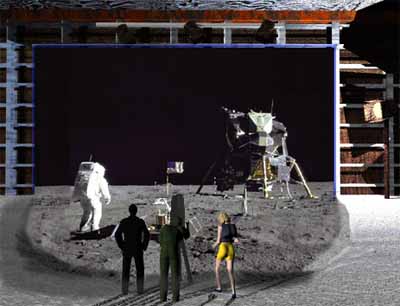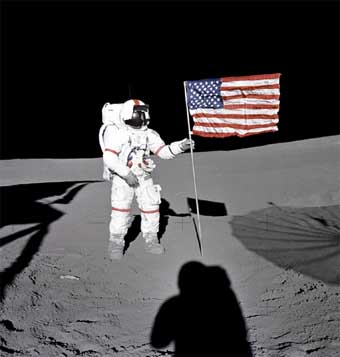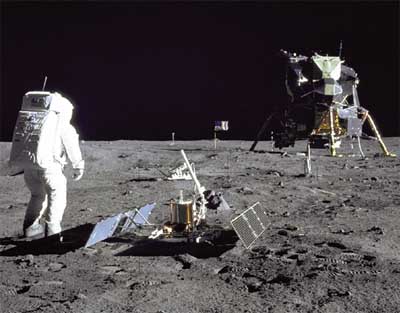pop up description layer
HOME
Cryptozoology UFO Mysteries Aviation Space & Time Dinosaurs Geology Archaeology Exploration 7 Wonders Surprising Science Troubled History Library Laboratory Attic Theater Store Index/Site Map Cyclorama
Search the Site: |
|
The Great Moon Landing Hoax
Somebody is certainly hoaxing us here, the question is whether it is NASA or the people that claim man never went to the moon... On July 20, 1969, astronaut Neil Armstrong set his boot on the surface of the lunar landscape. In that act he completed one of mankind's greatest achievements: Landing a man on the moon. Or did he? Some skeptics have suggested that those trips the Apollo spacecraft made to our nearest celestial neighbor may never have happened. According to these skeptics it was all an elaborate deception designed to make the world believe that the United States had beat the USSR to the moon after NASA figured out that they didn't have the technology to do it for real. Bill Kaysing, author of We Never Went to the Moon, is perhaps the most well-known skeptic of the manned moon landings. Kaysing was also a heavy contributor to a television special entitled Conspiracy Theory: Did We Land on the Moon? The program, hosted by Mitch Pileggi, first appeared on the Fox network in 2001 and has been repeated several times since then. The program raised a number of points that on first glance seem to make NASA's moon landing suspicious. On close scientific examination, however, most of these claims seem to fade like moonshine in the morning sun. No Stars in Sky Perhaps the first point raised, or at least the one most memorable, is the stars. Or more precisely, the lack of them. People who are skeptical of the moon landing point out that even though the sky in all the moon pictures is black, as it should be if there is no atmosphere on the moon (and there isn't), no stars can be seen. This is taken as an indication that the pictures were faked and NASA forgot to paint stars on the studio backdrop. The truth is that if you were to see stars in the sky in those moon pictures it would be a definite indication that they were faked. Why? Well, all the landings were done during daylight hours on the moon. That means that even though the sky was black, the sun was up. The lunar surface is mostly a light gray and reflects light extremely well. The light levels during the landings were probably similar to those in a western desert in the morning, bright enough to warrant sunglasses, or in the case of the astronauts, sunvisors on their spacesuits. For this reason the NASA cameras had to be stopped down (this mean a minimal amount of light was allowed to enter the camera) and the exposure times shortened to allow only enough light onto the film to properly illuminate the surface. The stars were much too faint to show up on these pictures. Expecting them to show up would be similar to going out into that western desert at midmorning, setting the camera properly to take pictures under those conditions, coming back after nightfall to take pictures of the stars without readjusting the exposure on the camera and then expecting to get something. Stars are hard enough to photograph under any conditions, let alone with an exposure setting appropriate for daylight. Ironically, many of the conceptual drawings of the moon landing done by NASA artists at the time show stars appearing in the lunar sky. It seems unlikely NASA would have forgotten to paint them on the backdrop if they were trying to fake it. Even modern NASA pictures of the space shuttle or earth from orbit do not usually show stars. This is for the same reason: When in direct sunlight the earth and and shuttle are very bright and the cameras must be stopped down too low to capture starlight. Shadows Too Light Moonlanding skeptics point out that if the photographs the astronauts supposedly took on the moon were actually taken there, the shadows should be absolutely black. The sun is the only source of light and there is no atmosphere to scatter the light around. In the images, though, the shadows are often well lit. Skeptics use the argument that this was because the shots were filmed in a studio that had an atmosphere. There is a basic misconception with this thinking, however. In a single light situation, shadows are filled in not just from the light rays being scattered by air. The light in the shadows also comes from being bounced off other objects. You can see this effect from a simple home experiment. Get two pieces of construction paper, one black and one white, then go into a dark room and light a single lamp. Place an object in front of you to create a shadowed area. Now bring the black construction paper near the shadow on a 45-degree angle partly facing the light, partly facing the shadow. Because the black paper is absorbing the light, the shadow does not change. Now slide the white construction paper in front of the black. The shadow should grow lighter from the light reflecting off the white paper. The same effect is present on the moon. The light bounces off the surface of the moon as well as the astronauts spacesuits and other equipment around the lander. Because the moon's surface is a light gray, and very reflective, the shadows can be lit very brightly. Non-Parallel Shadows Another argument often used to disprove the authenticity of the Apollo photographs involves the direction of the shadows. According to skeptics, the shadows in the NASA pictures appear to diverge. If the sun is the single bright light in the pictures, then the shadows should be parallel. This, according to NASA's critics, shows that the single light source was much closer to the astronauts than the sun, or there were multiple lights involved.
Clearly there were no multiple lights involved as there are no multiple shadows in the pictures. Whether the shadows appear to diverge, instead of running parallel is dependent on the camera lens used in taking the photographs. A slightly wide-angle camera, as was used on the moonwalk, can make parallel lines appear to diverge. Even so, some photographs (like the one to the right of Alan Shepard planting the flag) do not show any divergence at all, but the parallel shadows converge on the photo's vanishing point, just like they should. The Waving Flag While the American flag was being put up on the moon it appears to wave. Skeptics argue that this was caused by a breeze on the set where the hoax was filmed because a flag cannot wave in a vacuum. This is wrong thinking, however. The flag waves because the astronauts were wiggling the flagpole back and forth trying to get it to stick in the lunar soil. Given that kind of motion, any cloth would wave whether it is in a vacuum or not. Later on, still pictures show the flag apparently waving even after the astronauts have moved away from it. A glance at the moving video reveals that the flag is not waving. It simply had a ripple in it from not being fully extended across its length as it hung from its top supporting pole much like a gathered curtain. This was done accidentally on Apollo 11, but the astronauts loved this effect so much that they did it on every subsequent moonlanding. The Radiation Belt The van Allen belts are a region in space where Earth's magnetic field has trapped particles from the solar wind. Skeptics of the moon landing argue that an astronaut would get a lethal dose of radiation if he were to pass through the belts on the way to the moon. While continued exposure to the concentration of radiation found in the belts might well be fatal, the space capsule the astronauts were traveling in was going very fast and passed through the belts in a few hours. The metal hull of the capsule also gave the astronauts some protection from the radiation as well. While there was a certain risk in passing through the belts, as there is in every venture into space, the astronauts exposure from the van Allen belts was minimal: about 2 rem which is the equivalent of a 100 chest x-rays. Moon Dust and Feathers There are any number of points skeptics of the moon landing can bring up that don't "look right" to them, but all have simple scientific explanations when examined closely. Let's try doing the opposite: Look at some things seen on the video or in the pictures that would indicate that these things really happened on the moon. Phil Plait of the Bad Astronomy site points outs that video footage taken of some of the moon rovers shows dust being thrown up by the wheels as it rolls across the lunar surface. The dust rises and falls in nearly a perfect parabolic arc. This can only happen in a vacuum. Dust thrown up in earth's atmosphere would float and swirl around as it was carried by eddies in the air. Wherever the rover was at the time the video was taken, it was certainly in a location that had no air. Skeptics might argue that NASA took the trouble to build a sealed set and pump the air out, but this would be a tremendously difficult undertaking. It would also contradict evidence of the "waving" flag, as described above. Astronaut Dave Scott also did a quick physics lesson in front of the video camera during Apollo 15 that showed he was on the moon. He dropped a hammer and a feather and watched them fall to the ground. On Earth the feather's high wind resistance and low weight would have caused it to slowly drift slowly down. On the moon, however, the feather fell just as quickly as the hammer. Both dropped to the ground at exactly the same rate one would expect to see if the objects were being pulled to the ground by the moon's one-sixth Earth gravity. A Conspiracy of Numbers Even without the above evidence, the claim that the Apollo mission to the moon was fabricated by NASA makes little sense. For a conspiracy of silence to be effective, those involved must be very few in number. Every additional person added to the conspiracy raises the chances that somebody will, accidentally or on purpose, "spill the beans."
In the case of the Apollo program hundreds of thousands of people were involved. Not only NASA employees, but also the companies who were contractors of NASA for the project. Even if you argue that most of the contractors and much of NASA staff did not have to be in on the hoax, we are left with thousands of people who had direct knowledge of the events. Starting with the NASA employees that saw the astronauts climb into the rocket to the hundreds of sailors on the recovery ship that saw them emerge out of the space capsule when the trip was over. There are also hundreds of scientists that analyzed the rocks returned from the moon and had no doubt that they were authentic. The moon rocks brought back by the Apollo missions are not like anything else on Earth. They show the effect of billions of years exposure to vacuum, no moisture, and high energy cosmic rays. They are also pitted with tiny meteoroids. None show the burned effect typical of meteorites that have landed here on Earth. Could they have been faked? No. As one geologist put it, "It would be easier to just go to the Moon and get one." Who are the Hoaxers? The producers of Conspiracy Theory: Did We Land on the Moon? are undoubtably intelligent people who had the opportunity to research their subject thoroughly before filming their documentary, yet they seemed to have completely missed many of the simple explanations for the questions they raise. It makes one wonder: Who are the real hoaxers in this story? A Partial Bibliography Fox TV and the Apollo Moon Hoax by Phil Plait, http://www.badastronomy.com/bad/tv/foxapollo.html, 2003. Comments on the FOX Moonlanding Hoax special by Jim Scotti, Planetary Scientist, University of Arizona, http://pirlwww.lpl.arizona.edu/~jscotti/NOT_faked/FOX.html, 2001. The Great Moon Hoax by Dr. Tony Phillips, http://science.nasa.gov/headlines/y2001/ast23feb_2.htm, 2001. Copyright Lee Krystek 2003. All Rights Reserved. |
|
Related Links |
|
|






